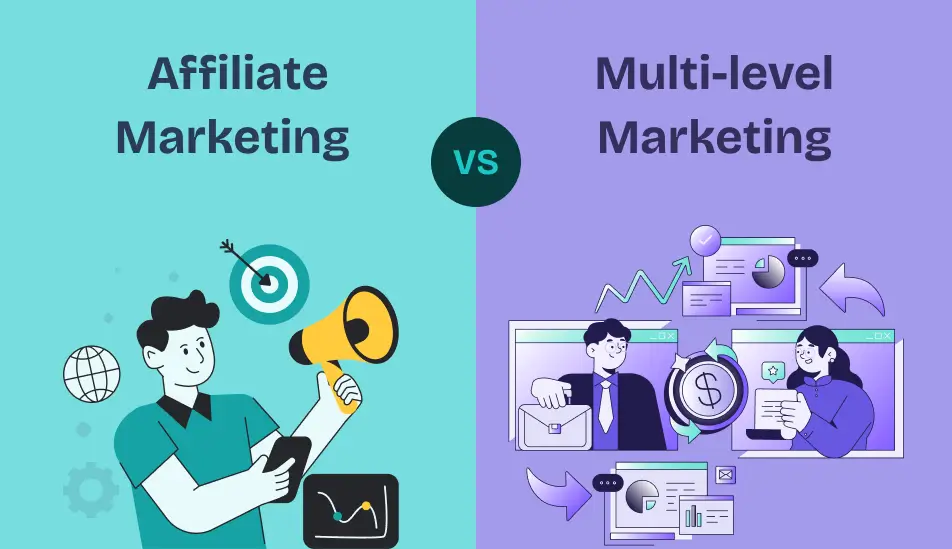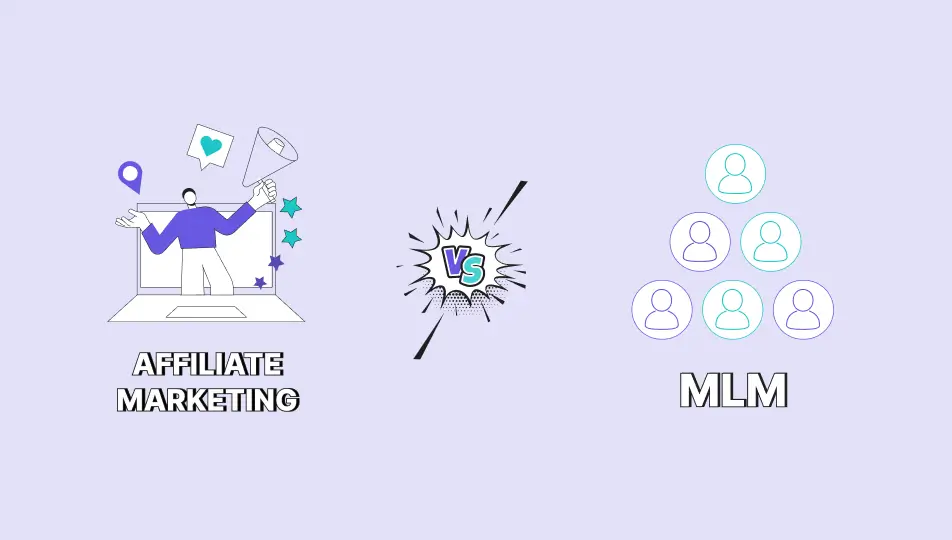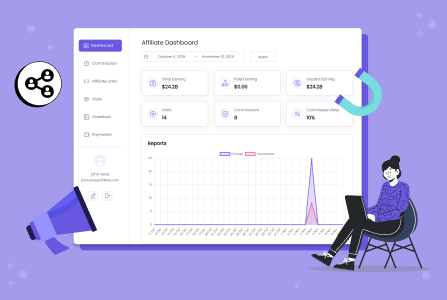Affiliate Marketing vs. MLM: What’s The Difference

Multi-level marketing (MLM), also known as direct selling or network marketing, is different from affiliate marketing. Mainly, by the earning structure and sales approach.
To understand the key differences in affiliate marketing vs MLM, we plan to take a closer look at their fundamental aspects:
- The roles and hierarchy in the marketing scheme.
- Costs and distribution/promotion channels.
- Earning potential.
- Legitimacy.
Want to learn the difference with our brief comparison? Here we go.
Affiliate Marketing vs. MLM: Who is Involved?
Affiliate marketing is often confused with MLM or influencer sponsorships – sometimes it’s at the intersection of the latter. Knowing the roles helps you understand how it works and whether it’s a suitable model for you.
Affiliate marketing roles
Affiliate marketing is traditionally based on the following roles:
1. Merchant
A company or individual (seller or vendor) who owns the product or service. For example, Amazon or Adidas.
You may be wondering here: Adidas? Fine. But Amazon doesn’t own or manufacture most of the products it sells. Exactly, but it is still considered a merchant – the payment processing, order confirmation, and customer service are all up to it. So, in terms of affiliate marketing hierarchy, such big online retail giants have a merchant role. And third-party promoters (affiliates) register in the affiliate programs of the brands.
2. Affiliate
A publisher or marketer is a person or business that promotes the merchant’s products, as a rule, using unique tracking links. However, influencers can often do that without any links.
Normally, a commission for every sale or generated lead is earned by an affiliate; at the same time, it can be just a fixed sum of money a merchant pays to an influencer. Think of social media influencers promoting offers or YouTubers linking to gear they use.
3. Customer
A person who buys a product or service through the affiliate link. While there are many digital rules for including affiliate earnings disclosures, customers are often unaware they’re part of an affiliate transaction.
Optional roles include affiliate networks (for bigger platforms that want to connect merchants with affiliates) and affiliate managers.
Multi-level marketing hierarchy
Multi-level marketing has a similar system of roles but a different hierarchy and principles.
MLM involves independent distributors who sell products directly to consumers, at the same time recruiting others and widening their network.
This helps them increase their revenue from multiple channels – personal sales and their recruitment success.
1. MLM Company (merchant/provider)
A company that owns and supplies the product or service being sold. Herbalife or Oriflame are well-recognised examples.
Sometimes they sell directly to customers, but more often, they sell through a network of individual distributors. The task of such a company is to provide the products, marketing materials, training resources, and handle shipping and customer support for the products. To sum up, in the MLM model, the MLM company is the merchant that sets the rules and payouts.
2. Distributor
Have you heard of consultants or representatives, as they call themselves?
These are individuals who join the MLM program to sell the company’s products and recruit others to do the same. This is the MLM version of the “affiliate” but with a twist. MLM distributors usually earn:
- A commission on their sales.
- Bonuses or residual income from the sales made by their recruits.
3. Downline and upline
There is something in the role structure that makes MLM unique compared to affiliate marketing. And this is the exact hierarchy which is absent in affiliate schemes (that’s why it’s ‘multi-line’, heh).
- Downline includes people a distributor recruits – and then their recruits – you got the point.
- Upline includes people above a distributor in the hierarchy, i.e., those who recruited them.
A distributor may earn a percentage of the sales from their down line.
4. Customer
A person who purchases the product from a distributor. In many MLMs, customers and distributors blur together; anyone who buys the product can usually become a distributor, sometimes automatically when they buy.
Still have questions? Let’s now compare the key differences based on the participants of the marketing system in the table below:
| Role | Affiliate Marketing | MLM |
| Merchant | Owns product/service (Amazon, Adidas) | MLM company owns the product (Herbalife, Amway) |
| Affiliate | Promotes product, earns commission per sale or per contract (influencers) | Sells products and recruits others (known as a distributor/consultant) |
| Customer | Buys a product via an affiliate link or by viewing an influencer’s content | Buys from a distributor, sometimes becomes one |
| Affiliate network | Connects merchants with affiliates (not necessarily, normally in big brands) | MLMs are centralised |
| Upline/downline | Not applicable | “Upline” > recruiter”Downline” > recruited members |
As you can already see from the table comparison, the dual-earning model (sales + recruitment) is what separates MLM from traditional affiliate marketing. What’s more, multi-level marketing distributors are also typically encouraged to purchase and use the products themselves, like using a subscription.
So, this is a key difference from affiliate marketing – customers typically remain just customers and are not enrolled in the business side like those in the MLM.
How Are Products & Services Promoted?

Unlike multilevel marketing, affiliate marketing’s focus is on content creation, trust, and scaling online reach, but not personal selling. The main promo methods of affiliate marketing include:
- Blog posts.
- YouTube videos.
- Social media.
- Email marketing/newsletters.
- SEO and content marketing.
MLM distributors usually build networks first, then sell them based on relationship-based marketing. Their goal is often to both sell and recruit. So, MLM methods generally boil down to the following:
- One-on-one sales (friends, family, or acquaintances).
- Social media.
- Private communication online and offline.
- Parties or events.
- Recruitment calls.
Startup Costs for Affiliate Marketing vs. MLM
Is it worth starting with affiliate marketing or MLM? Consider the resources you need to spend to start. These key ones are compared for your convenience in the table below.
| Factor | Affiliate Marketing | MLM |
| Startup costs | Signing up for an affiliate program is easy. Creating content is time and resource-consuming. | Buy a set of initial products or spend money each month. |
| Inventory | Affiliates don’t hold stock or buy products, but may need to buy subscriptions to test digital products. | Often required to buy/start with inventory or monthly purchases. |
| Ongoing costs | Content maintenance, emails, and partnerships. | Ongoing purchases of products or services. |
| Time to profitability | Fast with existing audiences. Slow with no content and audience and the beginning. | Slow (building sales and teams). |
Once again, you may better assess the investment and startup costs when you know what type of product you want to promote, whether you have an existing audience, and how you want to approach potential customers.
Earning potential

When choosing a type of marketing to be involved in, the question ‘How much will I earn?’ may be central. While there are many dependencies and we can’t answer it easily now, some general aspects can be compared. So, let’s compare the earning models of affiliate marketing vs MLM.
| Aspect | Affiliate Marketing | MLM |
| Commission | From direct product sales or agreed partnerships | From product sales + downline performance |
| Recruitment income | None | A big part of the income from recruiting others |
| Commission structure | Flat or tiered rates (5–30%) based on product or program | Rather complex. Bonuses, ranks, and team volume requirements |
| Passive income | Possible from content in different formats (video, blog, SEO) | From building a downline that continues to sell |
| Average earning | Varies, based on the performance and popularity. Small passive income. Top earners make 6+ figures | Many earn less than minimum wage |
Affiliate Marketing vs. MLM – What Are Risks & Legal Concerns?
When searching for the multi-level marketing definition on platforms like Investopedia, you will find out that there may be concerns raised about the legitimacy of MLM, while affiliate marketing is generally legitimate. So, should you care?

Affiliate marketing’s business model is generally legit when done with transparency:
- The business model is straightforward; someone who promotes products earns a commission.
- No recruitment required.
- Low risk (usually free to join, and no inventory is needed).
- Transparency: Many big brands and companies have affiliate programs.
- Legal standing for affiliate marketing is widely accepted and regulated, while FTC guidelines require disclosure of affiliate links.
MLM is often called legally grey, but it all depends on the actual company that is implementing this type of marketing.
Well, it’s not as bad as what Jordan Belfort (the Wolf of Wall Street) did, but it’s a legal, though sometimes controversial, business model. The key concerns and specifics include:
- Recruitment-focused models may resemble illegal pyramid schemes.
- More costs and risks are associated with buying starter products or regular subscriptions.
- High-pressure sales tactics may be used.
As for more risks, moreover, income claims are often exaggerated, and most participants earn little or lose money. That’s why some MLMs are legitimate (regulated and product-focused) – but others are prone to abuse and have been shut down for being deceptive.
Concluding
Now you know the key affiliate marketing vs. MLM difference and can make a better choice on what to join. Finally, none is about the get-rich-quick culture but rather a time-consuming investment, and is highly dependent on what type of sales approach you want to choose.




